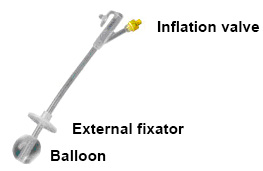Background
- Any individual presenting to Emergency Department (ED) with a dislodged gastrostomy should be considered as “Urgent” (within 60 minutes)
1. Identify when gastrostomy tube placed:
≤2 weeks: Cover stoma site and contact Gastroenterology/Radiology immediately.
≥2 weeks: Replacement by treating Doctor in the ED. See procedure for replacement below.
2. Assess if tube in situ:
No existing tube/Foley catheter keeping stoma site open
- Action: Attempt to keep stoma site open, exerting minimal force on insertion as per clinical judgment*
- *If unfamiliar with replacement, ensure Foley catheter insitu
- Options:
- Gastrostomy replacement, see below for guidelines
- or
- Place a Foley catheter until gastrostomy replacement possible (can use smaller size if indicated)
Existing tube/Foley catheter keeping stoma site open
- Action: Gastrostomy replacement, see below for guidelines
3. Commence procedure for replacement below
Note: If unsuccessful with gastrostomy replacement cover stoma site and contact Gastroenterology/Radiology immediately.
Procedure for replacement
Print copy this guidelinePreparation for placement:

- Aim to Identify French Size of Gastrostomy: Different French size may be required to fit current stoma
- Source Tube from stock on ED or patient may have replacement
- Positioning, ensure the patient is lying on flat bed/reclining chair
- Aseptic technique
- Inspect the tube prior to use:
- Fill the balloon with 5 ml or 20 ml of water, depending on balloon volume. This is printed on the inflation valve
- Completely deflate the balloon after inspection
- Check the external fixator to see that it slides up and down the shaft of the tube
- Remove the existing tube if insitu by removing all water from balloon
- Clean the stoma with normal saline
- Close the feeding port on the new tube
Placement
- Lubricate the tip with water-based lubricant or at least moisten the tip with water. Do not use a petroleum-based oil or jelly
- Guide the lubricated tip through the stoma and into the stomach .The replacement tube must be able to move freely in and out of the abdomen
- Inflate the balloon with sterile water. Balloon volume as per manufacturer’s instructions, this maybe printed on the inflation valve. Never inflate the balloon with air. Never overinflate the balloon
- Withdraw the tube, until tension is felt from the balloon contacting the stomach wall
- Slide the external fixator down the shaft of the tube until there is a space of ~5mm between the stoma and the fixation plate. Excessive tension should not be applied and the external fixator should not be sutured in place
- Check that the tube is in the correct position by aspirating gastric contents with a syringe and testing aspirate on pH indicator paper. If in doubt of position, have a gastrograffin study performed